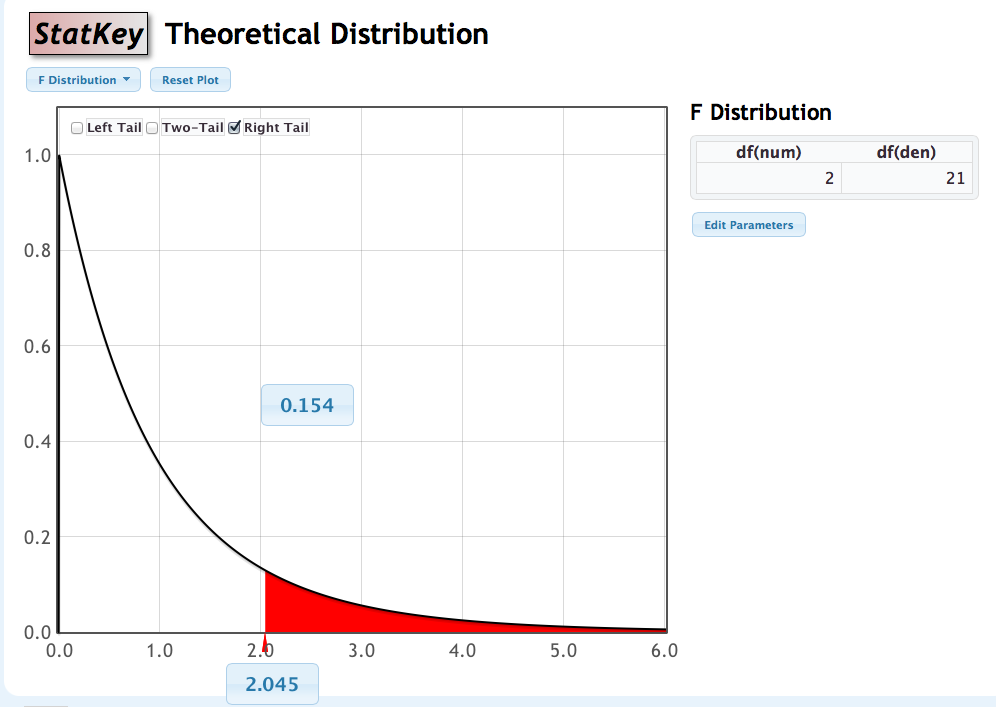Comparing Two or more Means
STAT 120
Inference tools (Classical methods)
Categorical Response
One proportion: sample z test/CI
Difference in 2 props: 2 sample z test/CI OR chi-square test
Association between 2 categorical variables: chi-square test
Quantitative Response
One mean: 1 sample t test/CI
Difference in 2 means: 2 independent sample t test/CI OR Matched pairs
Compare >2 means: One-way ANOVA
Multiple Categories
So far, we’ve learned how to do inference for a difference in means IF the categorical variable has only two categories (i.e. compare two groups)
In this section, we’ll learn how to do hypothesis tests for a difference in means across multiple categories (i.e. compare more than two groups)
Hypotheses
To test for a difference in true/population means across k groups:
\[\begin{align*} H_{0}:& \quad \mu_{1}=\mu_{2}=\ldots=\mu_{k}\\ H_{a}:& \quad \text{At least one } \mu_{i} \neq \mu_{j} \end{align*}\]
Frisbee Example
Does Frisbee grip affect the distance of a throw?
A student performed the following experiment: 3 grips, 8 throws using each grip
1. Normal grip
2. One finger out grip
3. Frisbee inverted gripA grip type is randomly assigned to each of the 24 throws she plans on making
- Response: measured in paces how far her throw went
- Question: How might you summarize her data?
Frisbee Example
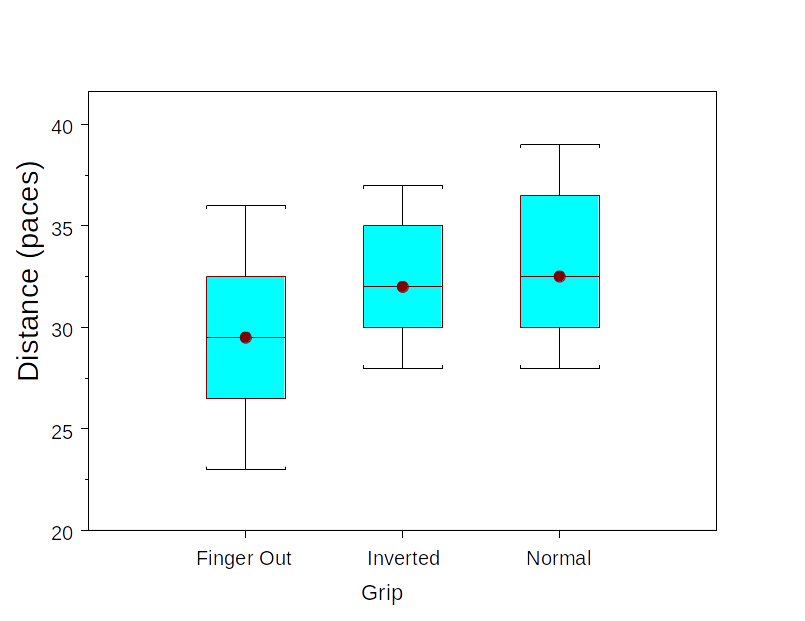
| Finger-out | Inverted | Normal | |
|---|---|---|---|
| n | 8 | 8 | 8 |
| Mean | 29.5 | 32.375 | 33.125 |
| SD | 4.175 | 3.159 | 3.944 |
Question: Is this evidence that grip affects mean distance thrown? \[\begin{align*} H_{0}:& \quad \mu_{1}=\mu_{2}=\mu_{3}\\ H_{a}:& \quad \text{At least one } \mu_{1}, \mu_{2}, \mu_{3} \text{ is not the same} \end{align*}\]
:::
Why Analyze Variability to Test for a Difference in Means?
The group means in Datasets \(A\) and \(B\) are the same, but the boxes show different spread.
Datasets \(A\) and \(C\) have the same spread for the boxes, but different group means.
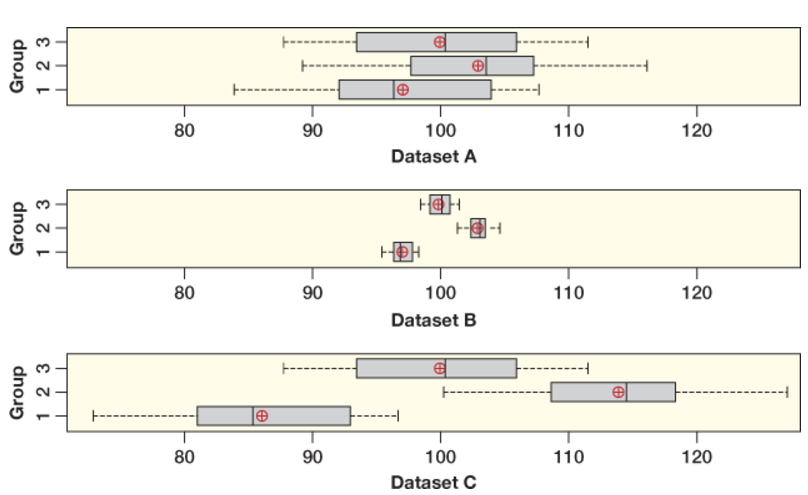
Which of these graphs appear to give strong visual evidence for a difference in the group means?
Why Analyze Variability to Test for a Difference in Means?
Dataset A = weakest evidence for a difference in means.
Datasets B and C = strong evidence for a difference in means.

Why Analyze Variability to Test for a Difference in Means?
Conclusion: An assessment of the difference in means between several groups depends on two kinds of variability:
- How different the means are between each groups
- The amount of variability within each groups

Analysis of Variance
Analysis of Variance (ANOVA) compares the variability between groups to the variability within groups
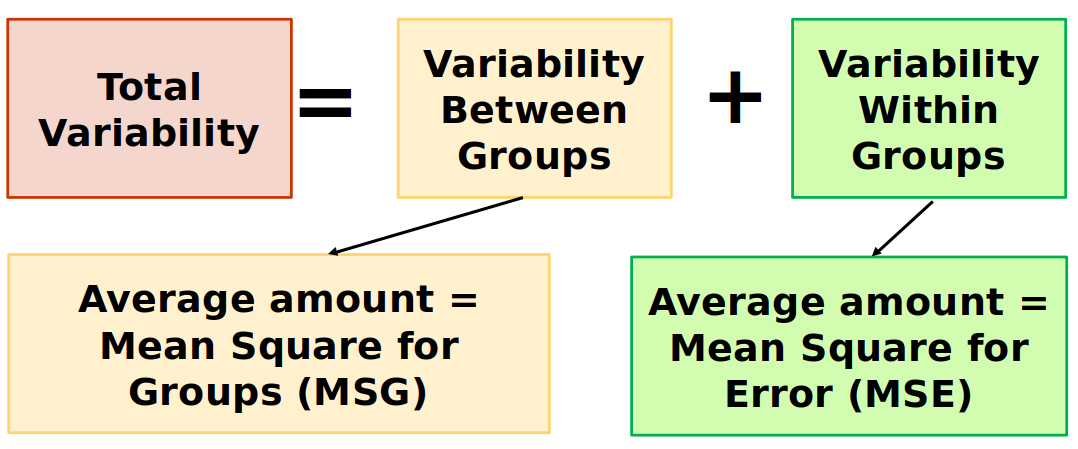
F-Statistic
The F-statistic is a ratio: \[F=\frac{M S G}{M S E}=\frac{\text { average between group variability }}{\text { average within group variability }}\]
If there really is a difference between the groups \((H_A \text{ true})\), we would expect the F-statistic to be
a). Large positive
b). Large negative
c). Close to 0
Click for answer
The correct answer is a.
Frisbee Example
How to determine significance?
We have a test statistic. What else do we need to perform the hypothesis test?
A distribution of the test statistic assuming \(H_0\) is true.
How do we get this? Two options:
Simulation
Theory
CarletonStats R package
F-Distribution
We can use the F-distribution to generate a p-value if:
- Sample sizes in each group are large (each \(n_{i} \geq 30\) ) OR the data within each group are relatively normally distributed
- Variability is similar in all groups
- The F-distribution has two degrees of freedom, one for the numerator of the ratio \((\boldsymbol{k}-\mathbf{1})\) and one for the denominator \((n-k)\)
- For F-statistics, the p-value (the area as extreme or more extreme) is always the right tail
F-distribution
Check assumptions: normality
Check Assumptions: Equal Variance
The F-distribution assumes equal within group variability for each group. This is also an assumption when using the randomization distribution.
- As a rough rule of thumb, this assumption is violated if the largest group standard deviation is more than double the smallest group standard deviation
Frisbee Example: Inference
Question: Is this evidence that grip affects mean distance thrown?
\[\begin{align*} H_{0}:& \quad \mu_{1}=\mu_{2}=\mu_{3}\\ H_{a}:& \quad \text{At least one } \mu_{1}, \mu_{2}, \mu_{3} \text{ is not the same} \end{align*}\] \(\mu_{\mathrm{i}}\) is the true mean distance thrown using grip \(i\). \[F=2.05(\mathrm{df}=2,21), \text {p-value}=0.1543\]
Conclusion: Do not reject the Null hypothesis. The difference in observed means is not statistically significant.
About 15% of the time we would see the grip differences like those observed, or even bigger, when there is actually no difference between the true mean distances thrown with different grips.
Picturing the variation
Green: Variation within groups
Blue: Variation between groups
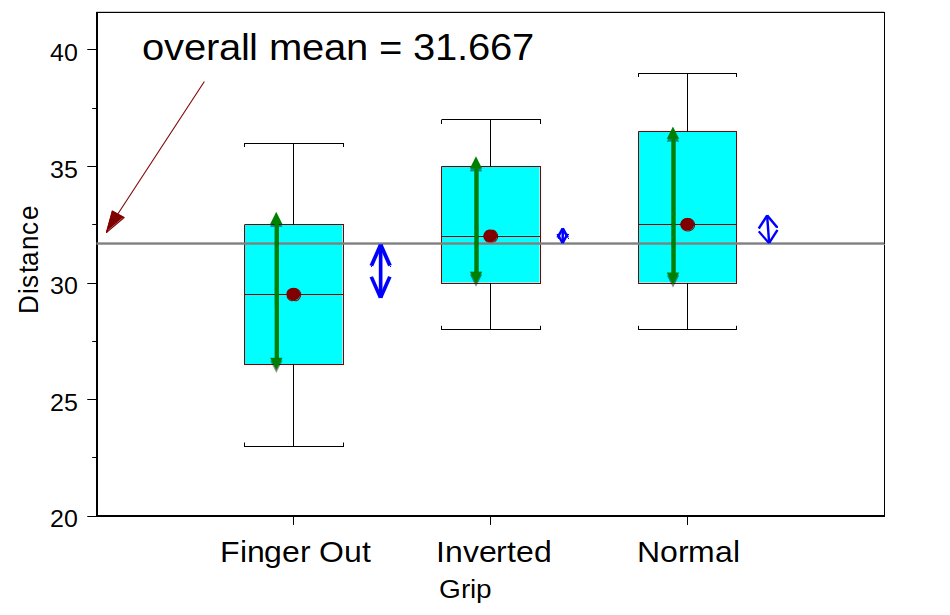
ANOVA Table for Frisbee data
\[\text{F-test stat} = 29.29/14.32 = 2.045\]
| Source | df | Sum of Squares | Mean Square |
|---|---|---|---|
| Groups |
#groups -1 3-1 = 2 |
SSG 58.583 |
SSG/df 58.583/2 = 29.29 |
| Error (residual) |
n - #groups 24-3 = 21 |
SSE 300.750 |
SSE/df 300.75/21= 14.32 |
| Total | n-1 24-1 = 23 |
SSTotal 359.333 |
ANOVA Table formula (don’t memorize!)
| Source | df | Sum of Squares | Mean Square |
| Groups | \( k - 1 \) | \( \sum_{\text{groups}} n_i (\bar{x}_i - \bar{x})^2 \) | \( \frac{SSG}{k - 1} \) |
| Error (residual) | \( N - k \) | \( \sum_{\text{groups}} (n_i - 1) s_i^2 \) | \( \frac{SSE}{N - k} \) |
| Total | \( N - 1 \) | \( \sum_{\text{values}} (x_i - \bar{x})^2 \) |
Frisbee Example: ANOVA table in R
Df Sum Sq Mean Sq F value Pr(>F)
Grip 2 58.58 29.29 2.045 0.154
Residuals 21 300.75 14.32 Group Activity 1

- Please download the Class-Activity-24 template from moodle and go to class helper web page
30:00 
